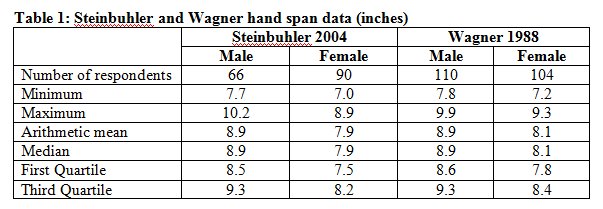Earlier hand span studies
Earlier hand span measurements have shown the great variation across the human population. Yoshimura and Chesky (2009) reported that the difference between the smallest and largest hand spans of nearly 400 musicians at the University of North Texas was 4 inches (11 cm). This is close to the width of five piano keys!
At the US Music Teachers National Association (MTNA) 2004 National Conference, David Steinbuhler measured the hand spans (thumb to fifth finger spans only) of 160 pianists. A mix of left and right hands were measured. The distribution of the pianists’ active 1-5 hand spans is shown in the chart below created by Steinbuhler (see: http://dsstandardfoundation.org/the-standards/). The gender difference is again obvious. He did not record the pianists’ ethnic background but is known to be mixed.

Comparing earlier pianist hand span data (Wagner, 1988) and the Steinbuhler data, the results are broadly consistent with the Australian study described in the page above. Note that the Wagner data is based on measurements from the centres of the fingertips rather than the outside edges. However this difference in measurement process is expected to affect 2-5 span (results not shown here) more than 1-5 span measurements. Assuming hand span data for a sufficiently large sample would approximate a normal distribution, various summary measures were derived by Wagner. Boyle & Boyle (2009) developed the summary measures for the Steinbuhler data. Table 1 summarises the differences between males and females for these two data sets. A significant proportion of subjects (95% of males and 86.5% of females) measured by Wagner (1988) were of Caucasian origin. The slightly larger spans for Wagner’s females is attributed to the particular music school where the survey was conducted having an international reputation. It would most likely attract students from many countries, with the result that those with very small spans may have been less likely to be selected.

Wagner (1984) also compared two groups of male pianists from his database: 26 he classed as ‘Successful performers’ (well-known soloists and winners of international competitions) with 10 ‘Problem cases’ (those who had struggled with technical or injury problems over a long period). The difference in their hand spans – 9.2 inches for the ‘Successful performers’ compared with 8.7 inches for the ‘Problem cases’ was statistically significant. The 2-5 spans for the successful group were also significantly larger.


